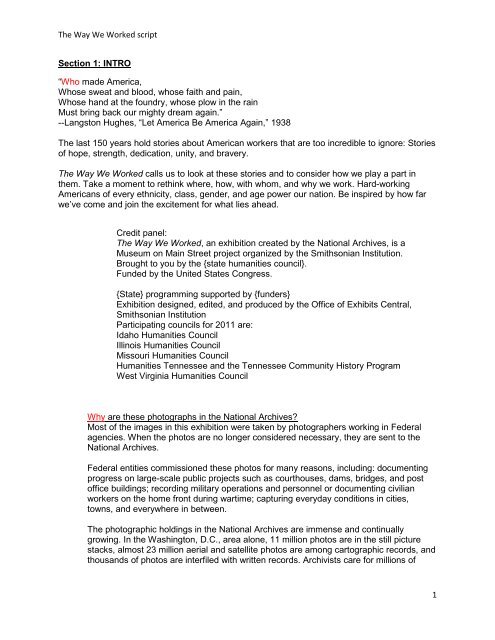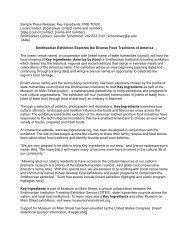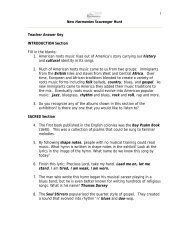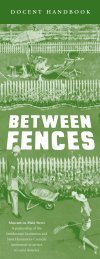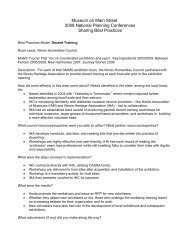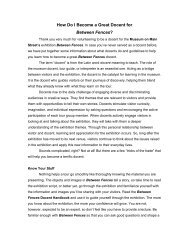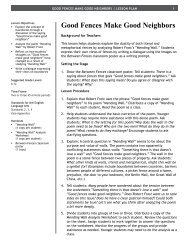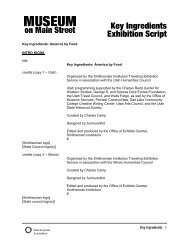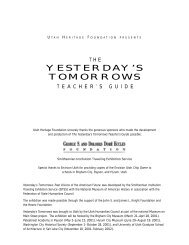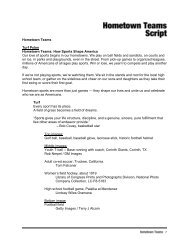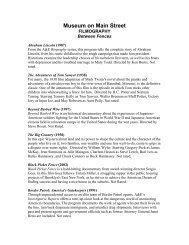Exhibition Script - Museum on Main Street
Exhibition Script - Museum on Main Street
Exhibition Script - Museum on Main Street
You also want an ePaper? Increase the reach of your titles
YUMPU automatically turns print PDFs into web optimized ePapers that Google loves.
The Way We Worked scriptSecti<strong>on</strong> 1: INTRO“Who made America,Whose sweat and blood, whose faith and pain,Whose hand at the foundry, whose plow in the rainMust bring back our mighty dream again.”--Langst<strong>on</strong> Hughes, “Let America Be America Again,” 1938The last 150 years hold stories about American workers that are too incredible to ignore: Storiesof hope, strength, dedicati<strong>on</strong>, unity, and bravery.The Way We Worked calls us to look at these stories and to c<strong>on</strong>sider how we play a part inthem. Take a moment to rethink where, how, with whom, and why we work. Hard-workingAmericans of every ethnicity, class, gender, and age power our nati<strong>on</strong>. Be inspired by how farwe’ve come and join the excitement for what lies ahead.Credit panel:The Way We Worked, an exhibiti<strong>on</strong> created by the Nati<strong>on</strong>al Archives, is a<str<strong>on</strong>g>Museum</str<strong>on</strong>g> <strong>on</strong> <strong>Main</strong> <strong>Street</strong> project organized by the Smiths<strong>on</strong>ian Instituti<strong>on</strong>.Brought to you by the {state humanities council}.Funded by the United States C<strong>on</strong>gress.{State} programming supported by {funders}<str<strong>on</strong>g>Exhibiti<strong>on</strong></str<strong>on</strong>g> designed, edited, and produced by the Office of Exhibits Central,Smiths<strong>on</strong>ian Instituti<strong>on</strong>Participating councils for 2011 are:Idaho Humanities CouncilIllinois Humanities CouncilMissouri Humanities CouncilHumanities Tennessee and the Tennessee Community History ProgramWest Virginia Humanities CouncilWhy are these photographs in the Nati<strong>on</strong>al Archives?Most of the images in this exhibiti<strong>on</strong> were taken by photographers working in Federalagencies. When the photos are no l<strong>on</strong>ger c<strong>on</strong>sidered necessary, they are sent to theNati<strong>on</strong>al Archives.Federal entities commissi<strong>on</strong>ed these photos for many reas<strong>on</strong>s, including: documentingprogress <strong>on</strong> large-scale public projects such as courthouses, dams, bridges, and postoffice buildings; recording military operati<strong>on</strong>s and pers<strong>on</strong>nel or documenting civilianworkers <strong>on</strong> the home fr<strong>on</strong>t during wartime; capturing everyday c<strong>on</strong>diti<strong>on</strong>s in cities,towns, and everywhere in between.The photographic holdings in the Nati<strong>on</strong>al Archives are immense and c<strong>on</strong>tinuallygrowing. In the Washingt<strong>on</strong>, D.C., area al<strong>on</strong>e, 11 milli<strong>on</strong> photos are in the still picturestacks, almost 23 milli<strong>on</strong> aerial and satellite photos are am<strong>on</strong>g cartographic records, andthousands of photos are interfiled with written records. Archivists care for milli<strong>on</strong>s of1
The Way We Worked scriptphotographic records in the Archives’ Presidential libraries and thousands more inregi<strong>on</strong>al facilities.Secti<strong>on</strong> 2: WHERE WE WORKEDImagine the darkness of a coal mine, fierce winds atop a skyscraper, waves of heat from afoundry against your skin, or the beeping of m<strong>on</strong>itors in modern hospitals. Where we workaffects us deeply. No two farms, ships, or offices are ever the same. A workplace changes overtime, creating new experiences and challenges. Either we mold it to fit our needs, or we adjustas best as we can.Where we work may seem obvious, but look around. Americans work just about everywhere!Background Image:ROW BY ROWAlthough technology helps, cultivating and harvesting crops is still laborintensive.A new term, “stoop labor,” was popularized by the 1940s to describethe physically demanding bending, pulling, and heavy lifting d<strong>on</strong>e by field handsevery day.Weeding sugar beets for $2.00 an hour near Fort Collins, Colorado,by Bill Gillette, June 1972.Nati<strong>on</strong>al Archives,Records of the Envir<strong>on</strong>mental Protecti<strong>on</strong> Agency“Put another seas<strong>on</strong>’s promise in the ground”--Field Behind the Plow, s<strong>on</strong>g by Stan Rogers, 1980Banner:Factories, Mines, Rivers, Offices, Stores, Oceans, Sky, Land,Communities, HomeBackground Image:Driving a steel piling, October 1935.Nati<strong>on</strong>al Archives,Records of the Bureau of Reclamati<strong>on</strong>,Engineering and Research Center2
The Way We Worked scriptRecords of the U.S. Fish and Wildlife ServiceShipping halibut caught in Puget Sound, Tacoma, Washingt<strong>on</strong>, byN.B. Miller, September 1888.Nati<strong>on</strong>al Archives,Records of the U.S. Fish and Wildlife ServiceHarvesting herring <strong>on</strong> the <strong>Main</strong>e coast, 1969.Nati<strong>on</strong>al Oceanic and Atmospheric Administrati<strong>on</strong>“Way, haul away, we’ll haul for better weatherWay, haul away, we’ll haul away Joe!”--Haul Away Joe, traditi<strong>on</strong>al sea chantey"If you d<strong>on</strong>'t watch it, you're g<strong>on</strong>na get knocked off the steel. Whensomething is coming toward me, I can feel it."--Mickey McD<strong>on</strong>ald (Mohawk, Akwesasne), skyscraper c<strong>on</strong>structi<strong>on</strong>worker, 1962HIGH ABOVE THE CITYC<strong>on</strong>structi<strong>on</strong> workers defy wind, cold, gravity, and even death. More than 3,400workers built New York City’s Empire State Building, the tallest building of its day.They blazed at a record pace for skyscraper c<strong>on</strong>structi<strong>on</strong> – 102 stories in just410 days.Workman <strong>on</strong> the framework of the Empire State Building, New YorkCity, ca. 1930-31.Nati<strong>on</strong>al Archives,Records of the Works Progress Administrati<strong>on</strong>IN THE MINESUnderground miners descend hundreds of feet into the earth to extract naturalresources like coal or copper. Danger is c<strong>on</strong>stant: flammable methane gas,carb<strong>on</strong> m<strong>on</strong>oxide, toxic dust, collapses, or injury from equipment. A “nipper,” like14-year-old Jo Puma (seated, bottom photo), opened mine doors for heavy coalwag<strong>on</strong>s.Crew of miners with coal wag<strong>on</strong>, Pittst<strong>on</strong>, Pennsylvania, January1911.Nati<strong>on</strong>al Archives,Records of the Children’s Bureau4
The Way We Worked script[Interactive Miner Hat]At the turn of the 20 th century, John Lukasavicius left Lithuania to join hisfather in a Pennsylvania coal mine. After just three weeks in the mines,he moved to Michigan to work in a furniture factory.“During the three weeks I spent there, I never saw the sunlight becausewe went down in the mine before the sun came out and we finished workafter the sun had set. I never saw any other part of the world aroundexcept the mine and the boardinghouse.”Interview, C<strong>on</strong>necticut Works Progress Administrati<strong>on</strong>,The University of C<strong>on</strong>necticut Homer Babbidge Library, 1939MILITARY SERVICEMilitary workers must be prepared for assignments in any type of envir<strong>on</strong>mentand deal with adversities every day. Thousands of men and women serve in theAir Force, Army, Marine Corps, Navy, Coast Guard, and Nati<strong>on</strong>al Guard today.They are soldiers, sailors, pilots, drivers, mechanics, doctors, draftsmen,translators, and teachers. Global threats take them to any corner of the world at amoment’s notice. Local crises might summ<strong>on</strong> them to help their homecommunities. The call of duty knows no boundaries.Iowa Army Nati<strong>on</strong>al Guard soldiers in Hills, Iowa,by Staff Sgt. Oscar M. Sanchez-Alvarez, U.S. Air Force, June 2008.Onboard the aircraft carrier USS Theodore Roosevelt, July 20, 2008.Photo by Mass Communicati<strong>on</strong> Specialist 3 rd Class J<strong>on</strong>athan Snyder.U.S. Department of Defense, U.S. Navy.[Spinner]MEDICINEA U.S. Army doctor operates in an underground surgery room in theSolom<strong>on</strong> Islands, December 1943.Nati<strong>on</strong>al Archives,Records of the Office of the Chief Signal OfficerMEDICINERural hospital operating room, Van Wert, Ohio, 1924.Nati<strong>on</strong>al Archives,Records of the Bureau of Agricultural Ec<strong>on</strong>omics[Spinner]FAITHA U.S. Navy chaplain c<strong>on</strong>ducts Mass for Marines at Saipan,by Sgt. Steele, June 1944.Nati<strong>on</strong>al Archives, Records of the U.S. Marine CorpsFAITHPriest offers Communi<strong>on</strong> at Holy Angels Catholic Church in Chicago,5
The Way We Worked scriptby John H. White, October 1973.Nati<strong>on</strong>al Archives, Records of the Envir<strong>on</strong>mental Protecti<strong>on</strong> AgencyU.S. Marines land an amphibious craft during battle, Tinian Island, inthe Pacific Ocean, July 1944.Nati<strong>on</strong>al Archives, Records of the U.S. Coast Guard“It is not just a job. The army really is your entire life….When you’redeployed, there isn’t any time off work.”--Battali<strong>on</strong> S-6 Officer Katie Brinn, United States Army SignalCorps, 2010IN OUR COMMUNITIESImagine even <strong>on</strong>e day without teachers, postal carriers, firefighters, policemen, busdrivers, or trash collectors. As our towns and cities grew, so too did the need for thesepublic servants. Although often uncelebrated or unseen, they are essential to ourmodern lives. These workers keep our communities and c<strong>on</strong>veniences running aroundthe clock.SACRIFICEThe attacks of September 11, 2001, focused nati<strong>on</strong>al attenti<strong>on</strong> <strong>on</strong> the work ofNew York’s firefighters and police officers. In the collapse of the World TradeCenter towers, more than 400 firefighters and policemen died. For weeks afterthe collapse, rescue pers<strong>on</strong>nel scoured the rubble to search for survivors and torecover victims.SAVING LIVESFirefighters risk fire, smoke, toxic gases, building collapse, explosi<strong>on</strong>s, heatexhausti<strong>on</strong>, and falling debris to save lives. They also act as medical firstresp<strong>on</strong>ders, c<strong>on</strong>tain forest and brush fires, or serve as community educators.A firefighter rescues a child, Internati<strong>on</strong>al Associati<strong>on</strong> of Fire Fightersphotograph, ca. 1960.Nati<strong>on</strong>al Archives, General Records of the Department of LaborBackground Image:Firefighters amidst the rubble of the World Trade Center, New YorkCity,by Andrea Booher, September 2001.Department of Homeland Security, Federal Emergency ManagementAgency6
The Way We Worked script“Teaching might even be the greatest of the arts since the mediumis the human mind and spirit.”--John Steinbeck, authorIN CLASSROOMSTeaching has seen big changes over the past 100 years. In the 1800s, anelementary teacher was typically a young woman who taught a mixed-aged classof schoolchildren in a single room. Increased focus <strong>on</strong> school reform and fundingby 1900 required that teachers be trained and certified.Background Image:Music teacher with children’s choral group, ca. 1935.Nati<strong>on</strong>al Archives,Franklin Delano Roosevelt Library[Spinner]MEDICINEA U.S. Army doctor operates in an underground surgery room in theSolom<strong>on</strong> Islands, December 1943.Nati<strong>on</strong>al Archives,Records of the Office of the Chief Signal OfficerMEDICINERural hospital operating room, Van Wert, Ohio, 1924.Nati<strong>on</strong>al Archives,Records of the Bureau of Agricultural Ec<strong>on</strong>omics[Spinner]FAITHA U.S. Navy chaplain c<strong>on</strong>ducts Mass for Marines at Saipan,by Sgt. Steele, June 1944.Nati<strong>on</strong>al Archives, Records of the U.S. Marine CorpsFAITHPriest offers Communi<strong>on</strong> at Holy Angels Catholic Church in Chicago,by John H. White, October 1973.Nati<strong>on</strong>al Archives, Records of the Envir<strong>on</strong>mental Protecti<strong>on</strong> AgencyCIVIC DUTYPublic works employees provide indispensable services to their communities,repairing highways, delivering mail, and removing trash. Exposed to hazardouschemicals and heavy machinery, and sometimes working through the night, theirjobs are dangerous and often underappreciated.“From the third floor windowYou watch the mailman’s slow progress7
The Way We Worked scriptThrough the blowing snow.As he goes from door to door”--The Mailman, poem by Franz Wright, 1998Letter carrier unlocks a mail collecti<strong>on</strong> box, ca. 1947.Smiths<strong>on</strong>ian Instituti<strong>on</strong>, Nati<strong>on</strong>al Postal <str<strong>on</strong>g>Museum</str<strong>on</strong>g>Sanitati<strong>on</strong> worker, Cleveland, Ohio,by John Alexandrowicz, April 1973.Nati<strong>on</strong>al Archives, Records of the Envir<strong>on</strong>mental Protecti<strong>on</strong> AgencyOLD JOBS, NEW JOBSWhile some jobs disappear, new <strong>on</strong>es c<strong>on</strong>tinue to rise. In 1910, milkmen went door-todoor,operators were in every elevator, and “pingirls” reset bowling pins. These jobs arememories now because of technological advances and changed social standards. Whatjobs were created or have disappeared in your lifetime? Now, imagine what the futureholds!Background Image:Lifting turbine blades with a crane, Golden, Colorado, April 2001,by Warren Gretz. Nati<strong>on</strong>al Renewable Energy LaboratoryYoung women delivering ice, 1918.Nati<strong>on</strong>al Archives,Records of the War Department General and Special Staffs[Staggered Image Interactive]Meatpacking plants had assembly lines, hoists, and ice-rooms by 1910,but processing is now faster and more sanitary.Cudahy Packing Co., Omaha, Nebraska, 1910.Nati<strong>on</strong>al Archives, Records of the Bureau of Animal Industry /Women processing and wrapping chicken, Magee, Mississippi,photo by Joe Valbuena, June 1977. U.S. Department of AgricultureSmall, family-run stands were the norm before <strong>on</strong>e-stop, nati<strong>on</strong>al discountretailers. An average Wal-Mart store today is about the size of twofootball fields.Fruit and vegetable stand, Center Market, Washingt<strong>on</strong>, D.C.,February 1915.Nati<strong>on</strong>al Archives,Records of the Bureau of Agricultural Ec<strong>on</strong>omics /A Wal-Mart Supercenter cashier and customer. 2001walmartstores.com, Inc.8
The Way We Worked scriptWITHIN FOUR WALLSAs America’s wealth, industries, and service-based ec<strong>on</strong>omy grew, more Americansthan ever came indoors to work. Increasingly, jobs are located within the four walls of anoffice, factory, store, or home. And these places change c<strong>on</strong>tinually as our societychanges. Take a look inside – there’s more than what meets the eye.Background Image:Tulip Town Market, Oak Ridge, Tennessee,by James Edward Westcott, July 1945.Nati<strong>on</strong>al Archives, General Records of the Department of EnergyIN THE MARKETDuring World War II, many Americans moved from farming communities to largertowns to support the war effort. Oak Ridge, Tennessee, was created in 1942 aspart of the U.S. atomic weap<strong>on</strong>s program. These women were am<strong>on</strong>g thehundreds who worked in the town’s first businesses.IN THE HOMEWhether raising children or doing chores – like these farmers (bottom photo) who“put up” their harvest in jars and cans – a home is a busy place! A parent’s labormay be unpaid, but professi<strong>on</strong>als in many fields, such as childcare and medicine,work inside their clients’ homes.“When you work in the house, you are working a big job. I lovedthat.”--Lucille Prest<strong>on</strong>, 1985From A World War II Journey: From Clarksdale, Mississippi, toRichm<strong>on</strong>d, California, 1942Farm family cans a butchered hog, Haskell County, Kansas,by Irving Rusinow, ca. 1940.Nati<strong>on</strong>al Archives, Records of the Bureau of Agricultural Ec<strong>on</strong>omicsPERSONAL WORKSTATIONS [<strong>on</strong> fence secti<strong>on</strong>]All-too-familiar office cubicles were invented in 1968 by Robert Propst, whocalled them “Acti<strong>on</strong> Offices.” He believed that the privacy and pers<strong>on</strong>alizati<strong>on</strong> ofpartiti<strong>on</strong>ed desks would improve productivity and morale. Forty years later, somegenerati<strong>on</strong>s of Americans have worked <strong>on</strong>ly in cubicles.Office building, Golden, Colorado,by Mike Linenberger, 2009.Nati<strong>on</strong>al Renewable Energy Laboratory9
The Way We Worked scriptWORKING FROM HOME [<strong>on</strong> fence secti<strong>on</strong>]Do you telecommute? In 2009, an estimated 45.1 milli<strong>on</strong> Americans worked fromhome offices at least <strong>on</strong>e day per week thanks to technology. That’s more thanthe combined populati<strong>on</strong>s of Texas and Florida!Home office, 2000.The Center for Universal Design, Centers for Disease C<strong>on</strong>trolIN A FACTORY [<strong>on</strong> fence secti<strong>on</strong>]The sec<strong>on</strong>d Industrial Revoluti<strong>on</strong> (1870-1914) expanded American industries andtechnology. World War II (1941- 45) made us a manufacturing powerhouse, withabout <strong>on</strong>e-third of workers employed in factories. Less than <strong>on</strong>e-tenth of today’slabor force are factory workers.Workers leaving after their shift, Columbia, Tennessee, 1958.Columbia, Tennessee, Black StarFAMILIES SHARE THE LOAD [<strong>on</strong> fence secti<strong>on</strong>]Does every<strong>on</strong>e in your household pitch in to help support your family? Mrs.Battaglia worked in a garment factory in 1908. On Saturdays she brought workhome so that her children, 12-year-old Tessie and 7-year-old T<strong>on</strong>y, could helpout. At two or three cents per garment, the family could earn $1.50 per day –enough for half of the week’s food bill.The Battaglia family sewing trousers, New York City,by Lewis W. Hine, January 1908.Nati<strong>on</strong>al Archives, Records of the Children’s Bureau[Graphic: Typewriters with percentages]JOIN THE OFFICE PARTYPercentage of Workforce in Managerial, Clerical, and Sales Jobs1940: Under 33%2009: Over 70%Interior view of Lever Brothers office building, New York City, LeverHouse photograph, ca. 1959.Nati<strong>on</strong>al Archives,Records of the U.S. Informati<strong>on</strong> Agency“Night Shift” poster by Nydorf, ca. 1944.Nati<strong>on</strong>al Archives,Records of the Office of Government ReportsDANGEROUS WORK, EVEN INDOORSBefore computer automati<strong>on</strong> and safer thermal suits, steel workers had veryclose encounters with molten hot ir<strong>on</strong> and flames. In the 1920s they fought forand w<strong>on</strong> a fair eight-hour workday. Today, steel mills and other factories c<strong>on</strong>tinueto run every minute of every day, thanks to workers <strong>on</strong> 8- and 12-hour shifts.Background Image:Tapping a blast furnace at the M. A. Hana Steel Co., near Buffalo,New York,by Thomas W. Parker, ca. 1950.Nati<strong>on</strong>al Archives,Records of the U.S. Informati<strong>on</strong> Agency10
The Way We Worked script[Shorthand book]By using symbols instead of words, secretaries could take down dictati<strong>on</strong>faster.Gregg Shorthand Guide, ca. 1900.Secti<strong>on</strong> 3: How We WorkedNothing affected the way we work like technology. Until the early 1800s, most jobs involvedmanual labor and animal power, but new inventi<strong>on</strong>s helped ignite an industrial revoluti<strong>on</strong>. Howwe worked changed forever.Mills and factories sprang up, towns were born, and innovati<strong>on</strong>s helped farmers produce more.Cottage industries gave way to city and factory jobs. Workers banded together in uni<strong>on</strong>s toprotect their rights and lives amid the industrial rush.Technology c<strong>on</strong>tinues to change how we work. How will it change our future?BEFORE THE SMARTPHONETeleph<strong>on</strong>e calls used to be switched manually. Skilled operators c<strong>on</strong>nected callsin less than 4 sec<strong>on</strong>ds and often gave local news and train alerts, too.Switchboard operators direct overseas calls, December 1943.Nati<strong>on</strong>al Archives, Records of the Women’s Bureau“Every great inventi<strong>on</strong> takes a livelihood away from 50,000 men &within ten years creates a livelihood for half a milli<strong>on</strong>.”--Mark Twain, letter to William Dean Howells, 1888Banner:Technology, Tools, Computers, Plow, Industry, Farms, United, Machines,HandcraftedBackground Image:Riveter at Hog Island Shipyard, Pennsylvania, 1918.Nati<strong>on</strong>al Archives, Records of the War DepartmentFROM AGRICULTURE TO INDUSTRYBeginning about 1830, waves of Americans left the countryside to work in cities, wherenew technology changed lives. In factories, mills, offices, and shops, life now revolvedaround the clock instead of the seas<strong>on</strong>s. Engineers and laborers built modern w<strong>on</strong>derswith huge machines.MOVING THE EARTHMammoth projects called for mammoth machines. Behemoths like the “five-yarddipper” helped the 12,000-pers<strong>on</strong> workforce build the Grand Coulee Dam. Mas<strong>on</strong>City, Washingt<strong>on</strong>—the first completely electric city in America—was built tohouse the workers.Worker <strong>on</strong> a “five-yard dipper” during c<strong>on</strong>structi<strong>on</strong> of Grand CouleeDam, Washingt<strong>on</strong>, April 1936.Nati<strong>on</strong>al Archives—Rocky Mountain Regi<strong>on</strong> (Denver, Colorado),Records of the Bureau of Reclamati<strong>on</strong>11
The Way We Worked script“A tool is but the extensi<strong>on</strong> of a man's hand, and a machine is but acomplex tool.”--Henry Ward Beecher, from the serm<strong>on</strong> “Earthly Immortality,” 1870MECHANIZING THE FARMAs more farmers left for the city, new tools, like tractors and threshers, helped fillthe labor gap by yielding more crops in less time with fewer people.Background Image:Corn planting in Tennessee,by Mari<strong>on</strong> Post Wolcott, May 1940.Library of C<strong>on</strong>gress, Prints and Photographs Divisi<strong>on</strong>Harrowing the fields, Shelby County, Iowa,by Irving Rusinow, May 1941.Nati<strong>on</strong>al Archives,Records of the Bureau of Agricultural Ec<strong>on</strong>omicsThreshing wheat by machine, Questa, New Mexico,by Irving Rusinow, ca. December 1941.Nati<strong>on</strong>al Archives,Records of the Bureau of Agricultural Ec<strong>on</strong>omicsTEXTILE TECHNOLOGYThe textile industry was <strong>on</strong>e of the first to transform America. Former farmworkers found themselves operating machines in noisy mills where lint filled thehot air. They moved fast to load bobbins of thread and to repair broken strands.Other laborers starched the threads or kept the machinery running by stokingfurnaces.[Graphic: 2 Barns]LEAVING THE FARMPercentage of Americans Who Are Farmers1900: 40 %2008: 2%[Flipbook: Technology & The Worker] WE RUN ON HUMAN POWERWomen sort sweet potatoes, Minnesota, October 1983.U.S. Department of AgricultureHELP IN THE HOME“Since I was in charge of the household during the day, I did the washand everything too. We had no hot water, so I heated all the hot water <strong>on</strong>the stove. I filled up the washer—we had the old, wringer-type washer—and I’d wash the clothes.”– Marian Eastman, a teenager in 1950s New JerseyAfter World War I, “modern homes” had gadgets: electric washingmachines, mangles (to wring water out of cloth), ir<strong>on</strong>s, and vacuumcleaners. Advertisers promised that they made chores a “joy!”12
The Way We Worked scriptFarm woman using her electric mangle, M<strong>on</strong>tgomery County, Indiana,--by J.M. Butzko, August 12, 1930.Nati<strong>on</strong>al Archives, Records of the Extensi<strong>on</strong> ServiceEastman interview (2000) from Remembering the 20 th Century: AnOral History of M<strong>on</strong>mouth County.--Courtesy M<strong>on</strong>mouth County Library, New JerseyUSE CAUTION“We [tested for radioactive residues] desks, drawer handles, any placewhere people were and the things [workers] touched.“I remember <strong>on</strong>e time we had to rope off the entire lab wing because ananalyst . . . c<strong>on</strong>taminated a hallway by spilling something <strong>on</strong> the floor andthen walked around with it <strong>on</strong> his shoe.”– Henry Peters<strong>on</strong>, former technician at the Idaho Nati<strong>on</strong>al LaboratoryTechnology made some jobs safer, but it also created dangerous jobsthat were unimaginable 100 years ago. Human experience is still crucialto read data and maintain safety.Operating a nuclear power plant turbine in Fort St. Vrain, Colorado,--by Bruce McAllister, May 1972.Nati<strong>on</strong>al Archives, Records of the Envir<strong>on</strong>mental Protecti<strong>on</strong> AgencyPeters<strong>on</strong> interview (1999) from Proving the Principle: A History of theIdaho Nati<strong>on</strong>al Engineering and Envir<strong>on</strong>mental Laboratory, 1949–1999,--by Susan M. StacyHANDCRAFTED“One day, <strong>on</strong>e of the young boys came up to me and he said, ‘The piece Iwant is this shape, but we cannot do it. . . . Is there any other place whereI can send the job out?’ . . .“I said I would rough it out <strong>on</strong> the milling machine, and <strong>on</strong> the lathe,and <strong>on</strong> the grinder, to get as close as possible, and then after Iwould freehand it. . . . I finished it completely by hand, with a file.”– Michel Bilger, was a toolmaker apprentice when he was 15 yearsoldThe skill of working by hand is increasingly rare. Yet surge<strong>on</strong>s,carpenters, and jewelers are am<strong>on</strong>g the many craftsmen whoknow, the most precise tools are their hands.Worker at Hamilt<strong>on</strong> Watch Company, Lancaster, Pennsylvania,--by Lewis W. Hine, ca. 1936–37.Nati<strong>on</strong>al Archives, Records of the Work Projects Administrati<strong>on</strong>13
The Way We Worked scriptBilger interview (1981) from C<strong>on</strong>necticut Workers and a Half Centuryof Technological Change, 1930-1980,--Archives & Special Collecti<strong>on</strong>s at the Thomas J. Dodd ResearchCenter, University of C<strong>on</strong>necticut LibrariesHELP FROM ANIMALS“C<strong>on</strong>cerning oxen, there must be 50–60 str<strong>on</strong>g and 14–16 horses besidesthose which bring food and fodder up here from the stati<strong>on</strong>. Four horsesare used for every load, but then you must believe that they make hugeloads! . . .“Enough to say that it is hard work with l<strong>on</strong>g days.”--Andrew P. Solem, Norwegian immigrant writing to his family fromEmpire Lumber Co. CampDraft animals like oxen and horses were indispensible co-workers beforemechanizati<strong>on</strong>. These animals hauled heavy loads and pulled everythingfrom canal boats and plows to logging sleds over frozen ground.Logs heading to market, Hur<strong>on</strong>-Manistee Nati<strong>on</strong>al Forest, Michigan,ca. 1887.--Nati<strong>on</strong>al Archives, Records of the U.S. Forest ServiceSolem letter (1891) from Andrew P. Solem Papers, 1879–1899.--University of Wisc<strong>on</strong>sin Digital Collecti<strong>on</strong>sON THE LINE“I experienced the famous ‘Ford Speed-Up.’ When I went to work at theplant in January, they were turning out 242 Ford cars a day, and youmultiply that by two and that’s how many right fenders I sandpaperedevery day. When I quit four m<strong>on</strong>ths later, we were turning out 535 cars aday, and I was sandpapering all the right-hand fenders just like I did at thebeginning without any extra help.”– Justin McCarthy, worked at a Ford assembly plant in the late 1930sThousands of Americans work <strong>on</strong> assembly lines, making everything fromradios to cars to toys. When Ford Motor Company began in 1903, it had<strong>on</strong>ly a few hundred workers. By the 1930s, the River Rouge Ford plantwas the world’s largest foundry with over 100,000 employees.Workers assemble radios, New York, 1945.--Nati<strong>on</strong>al Archives, Records of the Office of War Informati<strong>on</strong>McCarthy interview (1971) from Hard Times: An Oral History of theGreat Depressi<strong>on</strong>,--by Studs Terkel14
The Way We Worked scriptHUMAN INGENUITY“It was just after World War II, and electr<strong>on</strong>ics had started to move intohospital equipment . . . . I used to pick [my wife] up after work, and theywould say, ‘Earl, could you fix this device for us?’“So . . . a brother-in-law and I said maybe there’s a business in repairingmedical electr<strong>on</strong>ic equipment.“We just set up a repair service, and we were repairing every kind of thingthat was brought to us.”– Earl Bakken, Medtr<strong>on</strong>ics founder and maker of the first selfc<strong>on</strong>tainedpacemakerLewis Hine called this photograph “Mechanic in his shrine—the heart ofthe turbine.” Despite its size, the powerful machine w<strong>on</strong>’t last without usto care for it.Turbine mechanic, New York City,--by Lewis W. Hine, 1924.Nati<strong>on</strong>al Archives, Records of the Works Progress Administrati<strong>on</strong>Bakken interview (2007)--from The Institute of Electrical and Electr<strong>on</strong>ics Engineers HistoryCenter, New Brunswick, New Jersey[end flipbook]“When I die, d<strong>on</strong>'t bury me at all,Just hang me up <strong>on</strong> the spoolroom wall.Place a knotter in my hand,So I can spool in the Promised Land.”--Winnsboro Cott<strong>on</strong> Mill Blues, American ballad, early 20 th centuryMagnolia Cott<strong>on</strong> Mills spinning room, Magnolia, Mississippi,by Lewis W. Hine, May 1911.Nati<strong>on</strong>al Archives,Records of the Children’s BureauWorkers at Uni<strong>on</strong> Mills, Inc., stoke the textile plant’s furnaces,Huds<strong>on</strong>, New York,by S.G. Knowles, ca. 1917–18.Nati<strong>on</strong>al Archives,Records of the War Department, General and Special Staffs15
The Way We Worked scriptON THE ASSEMBLY LINESIn the early 1900s Henry Ford realized that it was easier to move parts ratherthan people. He improved the assembly line system by dividing eachmanufacturing process into a series of small tasks and installing c<strong>on</strong>veyor belts.Assembly line work takes skill and endurance for the fast-paced, l<strong>on</strong>g hours.Ford Motor Company workers <strong>on</strong> the first moving assembly line,Highland Park, Michigan, 1913.Nati<strong>on</strong>al Archives, Records of the U.S. Informati<strong>on</strong> AgencyAt the GM Assembly Divisi<strong>on</strong> plant, a car body moves overhead,by Gregory Heisler, Tarrytown, New York, 1981[Video: featuring assembly line work]IT’S A SMALL WORKING WORLD“Mr. Wats<strong>on</strong>, come here. I want to see you.”These were the first words spoken over a teleph<strong>on</strong>e in 1876 by Alexander Graham Bell.Since then, communicati<strong>on</strong> <strong>on</strong> the job has come a l<strong>on</strong>g way. We are c<strong>on</strong>nectedinstantaneously almost anywhere around the world by satellites, radios, computers, andhandheld devices. The digital revoluti<strong>on</strong> changed how we communicate at work, whetherin the corner store, <strong>on</strong> the farm, or in the emergency room.THE FIRST COMPUTERThe ENIAC (the Electr<strong>on</strong>ic Numerical Integrator and Computer) is c<strong>on</strong>sidered theworld’s first general-use electric computer. It was over 8 feet tall and 80 feet l<strong>on</strong>g.Originally built for the Army in 1946, the ENIAC helped pave the way forcomputers in the workplace.A programmer operates the ENIAC, ca. 1948.Nati<strong>on</strong>al Archives, Records of the U.S. Informati<strong>on</strong> AgencyMACHINES IN THE OFFICEAs businesses grew more complex, so did office technology. Invented in the late1800s, dictati<strong>on</strong> machines allowed office workers to compose letters by speakinginto a recording device. Typists then transcribed the recordings <strong>on</strong>to paper. Mostbusiness offices also had ticker-tape machines that relayed news from the stockmarket across the country.Stock ticker at the Waldorf-Astoria Hotel, New York City,by Underwood and Underwood, November 1918.Nati<strong>on</strong>al Archives,Records of the War DepartmentTranscribing records at the Dictaph<strong>on</strong>e Sales Corporati<strong>on</strong>, ca. 1925.Nati<strong>on</strong>al Archives,Records of the Women’s Bureau16
The Way We Worked scriptLOOK HOW FAR WE’VE COMECRITICAL LINKSThe lives of police officers, firefighters, astr<strong>on</strong>auts, and other high-risk workersdepend <strong>on</strong> enhanced communicati<strong>on</strong>s. Before the Detroit Police Departmentbecame the first in the country to have teleph<strong>on</strong>es in the stati<strong>on</strong>, people could<strong>on</strong>ly send electric signals to police via call boxes.America’s first female astr<strong>on</strong>aut, Sally Ride, communicates withground c<strong>on</strong>trollers, June 1983.Nati<strong>on</strong>al Archives, Records of the U.S. Informati<strong>on</strong> AgencyHIGH TECH – THEN AND NOWHow does your cell ph<strong>on</strong>e compare to this 1920s teleph<strong>on</strong>e? Advancementshelped make tools smaller and faster in the 20 th century. Teleph<strong>on</strong>es withoutdials or butt<strong>on</strong>s and manual typewriters gave way to wireless smartph<strong>on</strong>es andcomputer data cards.[Object Shelf]Kellogg teleph<strong>on</strong>e, ca. 1915; Manual typewriter, ca. 1925; Blackberry, ca.2007; IBM Tabulator computer punch cards, ca. 1960.New York City Police Department, ca. 1908.Library of C<strong>on</strong>gress, George Grantham Bain Collecti<strong>on</strong>INFORMATION FROM EVERYWHERECommunicati<strong>on</strong>s tools provide us with informati<strong>on</strong> and enable us to collaboratewith people all over the world in sec<strong>on</strong>ds. Inventi<strong>on</strong>s give rise to other inventi<strong>on</strong>s;teleprinters, for example, advanced the technology used by stock tickermachines.Worker receives news via teleprinter, December 1979.U.S. Department of AgricultureA farmer and an agr<strong>on</strong>omist review crop data,by Bruce Fritz, ca. 2005.U.S. Department of AgricultureMASSIVE DATA STORAGEBy the late 1960s, corporati<strong>on</strong>s and government agencies used mainframecomputers <strong>on</strong> a large scale. These machines processed data faster than ever,but required a large workforce (usually female) to punch data <strong>on</strong>to cards andcheck for errors, while technicians (usually male) mounted tapes and processedjobs.Computer complex for handling travel reservati<strong>on</strong>s, January 1968.IBM Corporate Archives[Graphic: Envelope]YOU HAVE MAIL, FASTER1860: P<strong>on</strong>y Express Mail – Missouri to California, 10 days1900: Western Uni<strong>on</strong> Telegraph – New York to California, same day2010: Broadband Internet Email – Internati<strong>on</strong>ally, in sec<strong>on</strong>ds17
The Way We Worked script“I remember the days when we used to lug around as c<strong>on</strong>sultantsthose 55-pound early portable computers. No w<strong>on</strong>der my lowerback kills me today!”--Laura E. Campbell, recalling her work for a c<strong>on</strong>sulting firm, ca.1980WORKERS UNITEThe rapid rise of industry in America increased productivity, but gave little c<strong>on</strong>cern forsafety. Many workers faced the possibility of physical injury, exploitati<strong>on</strong>, anddiscriminati<strong>on</strong> <strong>on</strong> the job. Some banded together in associati<strong>on</strong>s and uni<strong>on</strong>s, making theturn of the 20 th century into a hotbed of labor unrest from the mines to the railroads.Workers c<strong>on</strong>tinue to rebuke injustice and affirm their rights.“And by uni<strong>on</strong> what we willCan be accomplished still.Drops of water turn a mill,Singly n<strong>on</strong>e, singly n<strong>on</strong>e.”--American Miners’ Associati<strong>on</strong> s<strong>on</strong>g, 1864In March 1911, a fire at the Triangle Shirtwaist Factory in New YorkCity killed 146 workers. Later protests led to new laws governingworking c<strong>on</strong>diti<strong>on</strong>s.--Nati<strong>on</strong>al Archives, General Records of the Department of LaborChild LaborImagine this: It is 1912. You are 11 years old. Your father works in a shoe factory, andyour mother sews shirts at home. What is your job?Children traditi<strong>on</strong>ally helped with chores in the home or <strong>on</strong> the family farm. But in the1800s, many American children also worked in factories, mines, and mills.Employers liked to hire children because they could pay them low wages. Small fingerscould reach into looms when fibers were stuck. Small bodies could squeeze into tightspaces in mines. Many jobs were dangerous, but many families needed the m<strong>on</strong>eydesperately.Minimum age rules for child workers were finally set by the Fair Labor Standards Act in1938.Children string beans at a packing company, Georgia,--by Lewis W. Hine, June 1909.Nati<strong>on</strong>al Archives, Records of the Children’s BureauDOCUMENTING WORKLewis Hine photographed children at work around the country for the Nati<strong>on</strong>alChild Labor Committee. Children’s advocates used Hine’s photographs to enddangerous and abusive child labor practices.Young loom workers at Bibb Mill No. 1 in Mac<strong>on</strong>, Georgia,--by Lewis W. Hine, January 1909.Nati<strong>on</strong>al Archives, Records of the Children’s Bureau18
The Way We Worked scriptA four-year-old child picks berries in Maryland,--by Lewis W. Hine, June 1909.Nati<strong>on</strong>al Archives, Records of the Children’s BureauA “newsie,” St. Louis, Missouri,--by Lewis W. Hine, May 1910.Nati<strong>on</strong>al Archives, Records of the Children’s Bureau“ . . . no child will be sacrificed <strong>on</strong> the altar of profit!”--Mary Harris “Mother” J<strong>on</strong>es, workers’ rights advocateDEMANDING ACTIONEither in a uni<strong>on</strong> or independently, American workers have never been afraid todemand better wages and working c<strong>on</strong>diti<strong>on</strong>s. Highly visible events such asstrikes, sit-ins, boycotts, and protest s<strong>on</strong>gs, like those written by uni<strong>on</strong> organizerElla May Wiggins, could bring injustices to light and force change. Wiggins wasmurdered for her part in the Loray Mill strike in North Carolina in 1929.Butt<strong>on</strong>s from uni<strong>on</strong> supporters, ca. 1900–1950.[Interactive: Audio Box-Labor S<strong>on</strong>gs]“Roll the Uni<strong>on</strong> On”by John Handcox, 1937Classic Labor S<strong>on</strong>gs from Smiths<strong>on</strong>ian Folkway“Links <strong>on</strong> the Chain”by The Broadside Singers with Phil Ochs, 1964The Best of Broadside 1962-1988: Anthems of the AmericanUnderground from the Pages of Broadside Magazine“When Kentucky Had No Uni<strong>on</strong> Men”by George Davis, 1967When Kentucky Had No Uni<strong>on</strong> Men“De Colores”by Baldemar Velasquez and Aguila Negra, 1995Classic Labor S<strong>on</strong>gs from Smiths<strong>on</strong>ian Folkways“One Day More”by Elaine Purkey, 1995Classic Labor S<strong>on</strong>gs from Smiths<strong>on</strong>ian FolkwaysAll s<strong>on</strong>gs provided courtesy Smiths<strong>on</strong>ian Folkways Recordings.Early silver miner, Virginia City, Nevada,by Timothy O’Sullivan, 1867.Nati<strong>on</strong>al Archives, Records of the Office of the Chief of Engineers“But understand, all workers,19
The Way We Worked scriptOur uni<strong>on</strong> they do fear.Let’s stand together, workers,And have a uni<strong>on</strong> here.”--A Mill Mother’s Lament, s<strong>on</strong>g by Ella May Wiggins, 1929United Farm Workers protest poster, 1978.--Chicago Women’s Graphics Collecti<strong>on</strong>, Library of C<strong>on</strong>gress[Interactive Brotherhood of Electrical Workers Hat]Some workers, like truck driver Gary Sheatler, work without supervisi<strong>on</strong>or are self-employed. Joining a recognized uni<strong>on</strong> related to their tradeallows them to be a part of a collective voice. Whether uni<strong>on</strong> or not, theseworkers defend their independence fiercely.“Trucking’s a lot different than a 40-hour week job . . . . I figure I’mworking all the time, not just what the log book says. . . .“I have a lot of people I need to answer to, but <strong>on</strong>ce I have my truckloaded, and I crawl in the seat behind the steering wheel and shut thedoor, I’m my own boss.”--Interview, <str<strong>on</strong>g>Museum</str<strong>on</strong>g> <strong>on</strong> <strong>Main</strong> <strong>Street</strong>, 2009RISKY BUSINESSDangers <strong>on</strong> the job arise in different forms and situati<strong>on</strong>s. A miner faces cave-inswhile a chemist may handle toxic materials. The 1970 Occupati<strong>on</strong>al Safety andHealth Act (OSHA) allowed the Federal government to set and enforce healthand safety standards nati<strong>on</strong>wide. It required inspecti<strong>on</strong>s and allowed workers tofile complaints about unsafe c<strong>on</strong>diti<strong>on</strong>s.Activist Justin Dart Jr. (right) and other advocates at the DisabilityPride/Americans with Disabilities Act March in New York, July 25,1993. Signed by President George Bush in 1990, ADA guarantees fullaccess and protecti<strong>on</strong> for all Americans with disabilities.--Photograph courtesy of Yoshiko DartRadiati<strong>on</strong> isolati<strong>on</strong> booth, Arg<strong>on</strong>ne Nati<strong>on</strong>al Lab, Illinois, January1967.--Nati<strong>on</strong>al Archives – Great Lakes Regi<strong>on</strong> (Chicago),Records of the Atomic Energy Commissi<strong>on</strong>Secti<strong>on</strong> 4: Who Works?Our workforce is a lively kaleidoscope of young, old, female, and male from every ethnicity.Every talent and perspective adds a new facet.And this diversity remains str<strong>on</strong>g because of workers who dream big and work hard: Immigrantsand migrants start new lives throughout America; men and women fight for greater equality <strong>on</strong>20
The Way We Worked scriptthe job; and families turn businesses into legacies. Americans build a better future throughsacrifice, working from sunrise to sunset.Every<strong>on</strong>e can enrich the picture. Together, America works.A COMMUNITY OF WORKERSSouth Texas Panorama shows many of the agricultural, professi<strong>on</strong>al, andindustrial workers who keep communities running. During the Great Depressi<strong>on</strong>,federally commissi<strong>on</strong>ed artists celebrated American workers in murals, paintings,and sculpture.South Texas Panorama (Alice, Texas post office),by Warren Hunter, oil <strong>on</strong> canvas, 1939.Smiths<strong>on</strong>ian American Art<str<strong>on</strong>g>Museum</str<strong>on</strong>g>“I hear America singing, the varied carols I hear,Those of mechanics, each <strong>on</strong>e singing his as it should be blitheand str<strong>on</strong>g,The carpenter singing his as he measures his plank or beam . . .Each singing what bel<strong>on</strong>gs to him or her and to n<strong>on</strong>e else . . .”--I Hear America Singing, poem by Walt Whitman, 1855DREAMS AND OPPORTUNITIESWe have unceasing faith in America as a land of opportunity where “life, liberty, and thepursuit of happiness” is open to all. Dreams can come true. These ideals toucheverything, especially our right to work.These ideals inspired immigrants and migrants to uproot their lives to find work. Theyfueled the civil rights movement when African Americans, Hispanic Americans, and otherminorities fought to be included in the American dream.STARTING A NEW LIFEForty milli<strong>on</strong> immigrants came to America in the 20 th century al<strong>on</strong>e. After enteringcities like New York City, Galvest<strong>on</strong>, and San Francisco, they worked throughoutthe country, opened new businesses, and even founded new towns.Newly arrived immigrants leave a customs processing center at EllisIsland in New York Harbor.--Library of C<strong>on</strong>gress[Flipbook] MOVING FOR WORK: IMMIGRANTS & MIGRANTSSettlers in Red Lodge, M<strong>on</strong>tana, were mostly Finnish immigrants whocame to mine in the Beartooth Mountains.C<strong>on</strong>structi<strong>on</strong> of the Finnish Worker’s Hall, Red Lodge, M<strong>on</strong>tana, 1912.--Immigrati<strong>on</strong> History Research Center, University of Minnesota21
The Way We Worked scriptFINDING A NEW HOMEUya Anma (My Mother Dear)Let me take my leave, my mother.Earn m<strong>on</strong>ey and come home, my child.As I stay home and pray to the gods.To this Hawai’i from the faraway OkinawaWe have come all the way for the sake of m<strong>on</strong>ey.Thinking it’d <strong>on</strong>ly be a few years we came,But we have now grown our roots deep and with green leaves.-Nae Nakos<strong>on</strong>e, Japanese poet who immigrated to Hawai’iEarly Asian Pacific immigrants were recruited for labor-intensive jobs infactories, fields, or private homes in western states and Hawai’i. Manylived under harsh restricti<strong>on</strong>s with little pay, such as the Japanese inHawai’i. But Asian Americans built str<strong>on</strong>g communities where theyworked and carried <strong>on</strong> cultural traditi<strong>on</strong>s.Laborer of Japanese descent packing cauliflower <strong>on</strong> large-scaleindustrial ranch a few days prior to evacuati<strong>on</strong>,--by Dorothea Lange, Centreville, California, April 1942.Nati<strong>on</strong>al Archives, Records of the War Relocati<strong>on</strong> AuthorityNakos<strong>on</strong>e poem (1880) “Uya Anma (My Mother Dear: A Dialogue)”-- University of Hawai’i at Manoa, Center for Oral HistoryESCAPING POVERTY“I came looking for a way to send them m<strong>on</strong>ey. . . . I always thought aboutmy mother and my brothers. I never thought about making my life just forme.”- Jesus Martinez, worked as a bracero for nine years until he was able tobring his widowed mother and siblings to AmericaMore than 4.5 milli<strong>on</strong> Mexican workers were the heart of the largest guestworker program in U.S. history called the Bracero Program (1942–1964).(Bracero is the Mexican term for seas<strong>on</strong>al laborer.) When it began,workers were <strong>on</strong>ly guaranteed a minimum of 30 cents per hour eventhough the nati<strong>on</strong>al minimum wage was 45 cents per hour.Mexican irrigator works year round <strong>on</strong> large-scale farm,--by Dorothea Lange, Eloy District, Pinal County, Ariz<strong>on</strong>a, Nov 1940.Nati<strong>on</strong>al Archives, Records of the Bureau of Agricultural Ec<strong>on</strong>omicsMartinez interview (2000)--from Bracero History Archive, The Institute of Oral History at theUniversity of Texas at El Paso22
The Way We Worked scriptHOME FRONT OPPORTUNITIES“It was in ’42. My husband just came home <strong>on</strong>e evening and said thatthere was work in Richm<strong>on</strong>d, California, in the shipyards. ‘They’reopening up the Kaiser Shipyard, and I would like to go.’“So I said, ‘Why sure!’“. . . The trains were so full of the people coming out to California. . . I hadto stand up <strong>on</strong> the train. . . .”- Lucille Prest<strong>on</strong>, joined the Great Migrati<strong>on</strong> out of MississippiWorld War II created new jobs that were filled by 15 milli<strong>on</strong> Americans.Women and minorities entered the workforce to help with the war effort.A Chinese-American worker at U.S. Navy Yard, Mare Island,California, 1943.-Nati<strong>on</strong>al Archives,Records of Naval Districts and Shore EstablishmentsPrest<strong>on</strong> interview (1985)--from “A World War II Journey: From Clarksdale, Mississippi, toRichm<strong>on</strong>d, California, 1942” by Judith K. Dunning. The BancroftLibrary, University of California, Berkeley.A MOBILE LIFE“I cried when I left, but then I also felt that there was a new day for us inCalifornia because wages were better . . . .“When we left Oklahoma coming out here . . . I had $2 left over when wegot to Bakersfield. Just $2 to feed myself, my husband, and my s<strong>on</strong> andthat’s awful close. We went right <strong>on</strong> out to the ranch . . . . We got outthere [and] we started work the next day.”- Juanita Price, was a sharecropper and domestic servant beforemoving her family to California in 1936A migrant farming family may move two or three times during the year tofollow crop cycles. Before government camps, Great Depressi<strong>on</strong> migrantsbuilt makeshift shelters <strong>on</strong> land they had to rent weekly.African American cott<strong>on</strong> pickers ready to go to work in the field,--by Dorothea Lange, Eloy District, Pinal County, Ariz<strong>on</strong>a, Nov 1940.Nati<strong>on</strong>al Archives, Records of the Bureau of Agricultural Ec<strong>on</strong>omicsPrice interview (1981)--from “California Odyssey: The 1930s Migrati<strong>on</strong> to the Southern SanJoaquin Valley,” Oral History Program, California State College,Bakersfield23
The Way We Worked scriptCHILDREN ON THE MOVE“First, we went to Bainbridge to pick strawberries . . . . So, we had to workall through the summer, and when we finished there, we went into theYakima Valley . . . and if we got there early, we picked tomatoes.“The hardest part was when I had to pick <strong>on</strong>i<strong>on</strong>s. It was really hard. Wehad to straddle the row . . . and had the sack to our waist and we drug itand threw the <strong>on</strong>i<strong>on</strong>s in until it was about fifty pounds of <strong>on</strong>i<strong>on</strong>s. Thenwe’d drop it, pick up another sack, and move <strong>on</strong> through the row.”- Helen Paul, <strong>on</strong>e of nine siblings who worked to support the familyToday, 300,000 of the 1.3 milli<strong>on</strong> American migrant agricultural workersare between 12 and 18 years old. Children become invaluable workers forpoor families. Legally, a child agricultural worker 14 years or older canwork unlimited hours before or after school.Mexican boy, age 13, coming in from cott<strong>on</strong> field at no<strong>on</strong>. He picked27 pounds of Pima cott<strong>on</strong> to earn 45 cents in the morning,--by Dorothea Lange, Pinal County, Ariz<strong>on</strong>a, Nov 1940.Nati<strong>on</strong>al Archives, Records of the Bureau of Agricultural Ec<strong>on</strong>omicsPaul interview (1980)-- from “Washingt<strong>on</strong> Women’s Heritage Project,” Center for PacificNorthwest Studies, Western Washingt<strong>on</strong> UniversityFROM THE OLD COUNTRY TO NEW CITIES“I would like to go out to the land of Liberty where you are now and I hopewith the help of god I will so<strong>on</strong> be there, my dear Cousin . . . . DearCousin, this poor Island is in poverty. There is nothing going to keep it up<strong>on</strong>ly hunger and hardship . . . . When you do get this, do not delay butwrite as so<strong>on</strong> as this comes to hand . . . . Sending you all our kind Loveand Blessings.”– William Dunne, writing from Belfast, Northern IrelandClose to a third of Ireland’s populati<strong>on</strong> left between 1845 and 1855 toescape poverty and famine. Most Irish immigrants built canals, joinedrailroad crews, became fishermen, or worked as domestic servants.Irish clam diggers <strong>on</strong> a wharf, Bost<strong>on</strong>, Massachusetts, 1882.--Nati<strong>on</strong>al Archives,Records of the U.S. Fish and Wildlife ServiceDunne letter to John Curtis (April 2, 1851)--from Historical Society of Pennsylvania, Institute for Ethnic Studies[end flipbook]24
The Way We Worked script“We refuse to believe that there are insufficient funds in the greatvaults of opportunity of this nati<strong>on</strong>.”--Martin Luther King Jr., from “I Have a Dream,” 1963FROM ASIA TO AMERICAProbably fewer than 100 Chinese immigrants lived in California in 1847. By 1852and the discovery of gold, over 10,000 had arrived to escape poverty anddrought in China. They joined mining and railroad crews, but also becamefarmers, fishermen, and business owners. This success led to a backlash withthe Chinese Exclusi<strong>on</strong> Act of 1882, banning new laborers from entering thecountry.Workers at Lace House Dry Goods Co., a Chinese-owned business inSt. Louis, Missouri, ca. 1909.--Nati<strong>on</strong>al Archives – Pacific Regi<strong>on</strong> (Seattle),Records of the Immigrati<strong>on</strong> and Naturalizati<strong>on</strong> ServiceChinese shrimp fishers, San Francisco, California, 1889.--Gulf of <strong>Main</strong>e Cod Project, NOAA Nati<strong>on</strong>al Marine Sanctuaries;courtesy of Nati<strong>on</strong>al Archives[Graphic] SNAPSHOT: How Many Workers Were Foreign-Born?Lowell, MA: 1910 – 82% of weavers in the cott<strong>on</strong> millsAnac<strong>on</strong>da, MT: 1894 – 62% of workers at Anac<strong>on</strong>da Mining CompanySan Francisco, CA: 1910 – 56.4% of retail dealersPOSSIBLE DREAMSWhen they first arrive, immigrants often gravitate toward the same work andneighborhoods as family and friends. They take entry-level jobs that they hopewill be stepping-st<strong>on</strong>es to bigger things. Today, many skilled immigrants achievehigh-level positi<strong>on</strong>s, especially in science, technology, and educati<strong>on</strong>.Dr. Beheruz N. Sethna, of the University of West Georgia, is the firstIndia-born president of an American university.--Photograph courtesy of the University of West Georgia, 2010Looking for work at an employment agency for Italian-Americans, SanFrancisco, California.--Nati<strong>on</strong>al Archives, Franklin Delano Roosevelt Presidential LibraryGREAT MIGRATION“The North symbolized to me all that I had not felt and seen.”- Richard Wright, from Black Boy (1945)In 1900, the majority of African Americans lived in the rural South. Beginning with WorldWar I, milli<strong>on</strong>s of African Americans left in search of new opportunities. They found workin places like factories, offices, in private homes as maids and cooks, and in serviceindustries.25
The Way We Worked scriptIn 1950, more African Americans worked in blue-collar jobs than in agriculture. Theyowned their own businesses, and developed vibrant, urban communities. By 1970, fivemilli<strong>on</strong> African Americans had moved north or west.“There can be no solidarity if <strong>on</strong>e is c<strong>on</strong>sidered a Black worker andanother a White worker. We should be c<strong>on</strong>sidered just a worker.”--A. Philip Randolph, civil rights pi<strong>on</strong>eer, 1935PAVING THE WAYPullman Palace Car employed more African Americans than any other company.Working as porters <strong>on</strong> passenger trains, they put in l<strong>on</strong>g hours with little rest, butbecame the base of an African American middle class. Members of theBrotherhood of Pullman Porters, like A. Philip Randolph, became communityleaders and civil rights activists. They helped pave the way for all minorities inprofessi<strong>on</strong>al fields.Porters in Erie Railroad lounge car, ca. 1949.--Nati<strong>on</strong>al Archives,Records of the U.S. Informati<strong>on</strong> Agency, Erie Railroad CompanyphotographJournalist Ted Post<strong>on</strong> led the Office of War Informati<strong>on</strong> Negro PressSecti<strong>on</strong> and advised President Roosevelt, Washingt<strong>on</strong>, D.C., ca.1941.--Nati<strong>on</strong>al Archives, Records of the Office of War Informati<strong>on</strong>MIGRANT WORKMilli<strong>on</strong>s of Americans live hard, unsettled lives as migrant workers. Agriculturalworkers move c<strong>on</strong>stantly with the seas<strong>on</strong>s to harvest crops.Mexican farm worker in lettuce field, Blythe, California,--by Charles O’Rear, May 1972.Nati<strong>on</strong>al Archives, Records of the Envir<strong>on</strong>mental Protecti<strong>on</strong> AgencyFAMILY FARMSFamily farms are ic<strong>on</strong>s of independence. For new immigrants, owning a farm was afoothold in a new country. For many children, farm life defined the American work ethic.Some farmers struggled as agriculture grew focused <strong>on</strong> expensive technology andc<strong>on</strong>solidati<strong>on</strong>. Many left agriculture, but the family farms that remain are important for theec<strong>on</strong>omy and sustainability.Children feeding pigs, Beltsville, Maryland, ca. August 1973.--U.S. Department of AgricultureHerbert Allen works with his s<strong>on</strong> Trentis <strong>on</strong> the Allen family farm,Humphreys County, Mississippi, June 1996.--U.S. Department of Agriculture26
The Way We Worked script“Part of the challenge of being a farmer and self-employed isyou . . . have to know a little bit about everything, being a ‘Jack-ofall-trades’. . . ”--Michael Mann, fifth-generati<strong>on</strong> farmer from Boykins, VirginiaInterview, <str<strong>on</strong>g>Museum</str<strong>on</strong>g> <strong>on</strong> <strong>Main</strong> <strong>Street</strong>, 2011[Interactive farmer hat]Pat and Shar<strong>on</strong> O’Toole planned to attend law school, but decidedinstead to carry <strong>on</strong> the legacy of the ranch that their family has owned formore than a hundred years. The ranch became their life’s work, and theyintend to pass it <strong>on</strong> to their two children.Pat: “We’re very blessed to have children that ‘get it.’ They’ve beenworking since they were old enough to hold a branding ir<strong>on</strong>.”Shar<strong>on</strong>: “It’s just a w<strong>on</strong>derful piece of landscape, and it’s ourresp<strong>on</strong>sibility and privilege to work <strong>on</strong> it and try to keep it going.”--Interview, <str<strong>on</strong>g>Museum</str<strong>on</strong>g> <strong>on</strong> <strong>Main</strong> <strong>Street</strong>, 2009Farmer in Shelby County, Iowa,--by Irving Rusinow, ca. May 1941.Nati<strong>on</strong>al Archives, Records of the Bureau of Agricultural Ec<strong>on</strong>omicsAT ANY AGEWe work a lot and for a l<strong>on</strong>g time. Some of us start at very young ages in a familybusiness—feeding animals <strong>on</strong> a farm, setting silverware in a diner, or lending a hand ina store. Others start as teenagers with summer jobs or internships.Americans are working l<strong>on</strong>ger today even than just a generati<strong>on</strong> ago.WORK NEVER STOPSAmericans are no strangers to “burning the midnight oil.” Factories, businesses,and mines operate around the clock in shifts. Tasks completed at night or early inthe morning help keep daytime workers going without missing a beat.G.E. Mitchell works overtime at night, Washingt<strong>on</strong>, D.C.,--by Joseph O’D<strong>on</strong>nell, September 1949.Nati<strong>on</strong>al Archives, Records of the U.S. Informati<strong>on</strong> AgencyEarly morning delivery to E&A Soul Food Restaurant, Paters<strong>on</strong>, NewJersey,--by Susan Levitas, August 1994.Library of C<strong>on</strong>gressWORK HARD, GET AHEADThis Office of War Informati<strong>on</strong> poster from World War II promotes the spirit of anAmerican work ethic: hard work will protect our freedoms.Poster, “This Is America, Keep It Free.”--Nati<strong>on</strong>al Archives, Records of the Office for EmergencyManagement, Office of War Informati<strong>on</strong>27
The Way We Worked scriptWHAT WAS YOUR FIRST JOB?High school and college-age students often find jobs in the retail and food serviceindustries. Many become interns or apprentices to older workers, learning skillspassed <strong>on</strong> through generati<strong>on</strong>s. In their first ten years as wage earners, youngworkers may hold as many as seven different jobs.[Graphic]10The average number of jobs an American has before turning 36 yearsold.50The percentage of Baby Boomers (34 milli<strong>on</strong>) who expect to work afterage 70.A young woman works at drive-in restaurant, Rifle, Colorado,--by David Hiser, July 1973.Nati<strong>on</strong>al Archives, Records of the Envir<strong>on</strong>mental Protecti<strong>on</strong> AgencyA young member of the Dannheim family makes chocolate ice creambars in his family’s dairy, New Ulm, Minnesota,--by Flip Schulke, July 1974.Nati<strong>on</strong>al Archives, Records of the Envir<strong>on</strong>mental Protecti<strong>on</strong> AgencyA veteran naval yard employee instructs an apprentice, ca. May 1942.--Nati<strong>on</strong>al Archives, Franklin Delano Roosevelt Library Public DomainPhotographs[Video: “What Was Your First Job?”]WOMEN AGAINST THE ODDSDelicate. Simple-minded. Timid.Generati<strong>on</strong>s of women struggled against stereotypes like these to win equality in theworkplace. Their grit and willingness to tackle any job created more opportunities for allwomen.Over the 20th century, women increasingly earned jobs usually held by men and provedmore than capable. Women entered the workforce at higher levels of power and startedtheir own businesses. Succeeding generati<strong>on</strong>s of girls are determined to follow theirdreams.CONTRIBUTING TO THE WAR EFFORTAs more male workers joined the armed forces during World Wars I and II,women filled their jobs <strong>on</strong> the home fr<strong>on</strong>t. Women who served the countrythrough wartime work made celebrated c<strong>on</strong>tributi<strong>on</strong>s to industry and gave rise tothe image of “Rosie the Riveter.”28
The Way We Worked scriptWomen working <strong>on</strong> Great Northern Railway locomotive, Great Falls,M<strong>on</strong>tana, ca. March 1918.--Nati<strong>on</strong>al Archives, Records of the Women’s BureauTO SERVE THEIR COUNTRYMore than 400,000 women served in the American military during World War II,but were discouraged from pursuing military careers when it ended. However,cultural views began to change during the 1970s and 1980s. Women advancedin every level and branch of the military, comprising roughly 16 percent of totalarmed forces pers<strong>on</strong>nel by 2009.U.S. Navy WAVES recruitment poster, ca. 1941–45.--Nati<strong>on</strong>al Archives, Records of the Office of Government ReportsU.S. Army recruitment poster, 1990.--Nati<strong>on</strong>al Archives,Records of the U.S. Army Training and Doctrine Command[Interactive military hat]Katie Brinn decided to carry <strong>on</strong> the Brinn family military legacy, followingthe service of her grandfather (Navy), father (Army), and mother (ArmyNurse Corps). She joined the U.S. Army Signal Corps in 2006.“Serving the country is something that my family has always been big <strong>on</strong> .. . and they impressed that up<strong>on</strong> me from a young age.”--Interview, <str<strong>on</strong>g>Museum</str<strong>on</strong>g> <strong>on</strong> <strong>Main</strong> <strong>Street</strong>, 2009MULTITASKINGIn the 1970s, debates raged about how and if women should balance work andfamily resp<strong>on</strong>sibilities. But for women working <strong>on</strong> the farm, this issue was nothingnew.Jean Schnelle works <strong>on</strong> her family farm while caring for her s<strong>on</strong>Dwight, Lockwood, Missouri,--by Michelle Bogre, ca. 1978.Nati<strong>on</strong>al Archives, Records of the U.S. Informati<strong>on</strong> Agency“Something which we think is impossible now is not impossible inanother decade.”--C<strong>on</strong>stance Baker Motley, first female African American federal judgeSMASHING THE GLASS CEILINGEarly in the 20th century, women entering the white-collar workforce foundmostly clerical work. Their limited advancement up the career ladder was termeda “glass ceiling”: You could see the upper levels, but you couldn’t get there.Breaking that ceiling to managerial and executive ranks took activism, legislati<strong>on</strong>,and women proving themselves as equals day-in and day-out since the 1960s.29
The Way We Worked scriptExecutives in a business meeting, Kansas City, Missouri,--by Scott Lute, 2009.Photograph courtesy of Country Club BankCensus Bureau workers review data, Washingt<strong>on</strong>, D.C., ca. 1940.--Nati<strong>on</strong>al Archives, Records of the Census Bureau[Graphic]A CHANGING WORKFORCEPercentage of married mothers working outside the home1975 - 37%; 2000 -- 63%IN MEDICINE AND SCIENCEAs women gained ground in graduate-level school enrollment and medicalprograms during the sec<strong>on</strong>d half of the 19th century, they broke through barriersin medicine and science professi<strong>on</strong>s.Secti<strong>on</strong> 5: Why We WorkEllen Lew analyzes a sample to identify amino acids, Berkeley,California, ca. 1976.--Nati<strong>on</strong>al Archives, Records of the Office of the Secretary ofAgricultureDr. Anita Figueredo reviews x-rays, Washingt<strong>on</strong>, D.C., 1944.--Nati<strong>on</strong>al Archives, Records of the Office of War Informati<strong>on</strong>Work is practical, providing an income and the means for survival.Work is challenging, testing our physical and intellectual limits.Work is fulfilling, giving us an identity and a chance to fulfill dreams.Work is communal, uniting us and sustaining communities.Work has value. Why do you work?A COMMON PURPOSEThe people of Newport News have a 150-year-old heritage of shipping andshipbuilding. Proud shipbuilders and their excited families c<strong>on</strong>tinue to crowdlaunches of new ships as they did in 1939 for a ship built for the World’s Fair.Ship launch in Newport News, Virginia, 1939.--Photograph courtesy of The Library of Virginia“The best prize that life has to offer is the chance to work hard atwork worth doing.”--Theodore Roosevelt, 26th President of the United States30
The Way We Worked scriptCOMMUNITIES AT WORKSome communities become famous for their local industries. These businesses are asource of pride, often linked to local heritage and traditi<strong>on</strong>. Their workers become a kindof hometown hero. Towns celebrate their sweat and skill with festivals, c<strong>on</strong>certs,parades, sports teams, and even the city nickname.Workplaces create community, too. Co-workers draw strength from <strong>on</strong>e another in bothgood and stressful times. Friendships extend to the ballpark for softball games, bowlingalley, or uni<strong>on</strong> hall where their families meet.Take a look around at every<strong>on</strong>e in your work community.[Interactive steelworker’s hat]Steel mills are fiery, dangerous places and gave steelworkers areputati<strong>on</strong> of toughness. When Robert Buday started at the Homestead(Pennsylvania) Steel Works in 1956, no <strong>on</strong>e was given a face shield, andmost workers just wore regular clothes.“I worked at heat-treat and forge as laborer and moved up to hooker,which meant you hooked up steel and put it in the furnace . . . . And thefurnaces were around 2,000 degrees.“You put your hand in fr<strong>on</strong>t of your face, that’s all; that was yourprotecti<strong>on</strong>.”--Interview, Rivers of Steel Heritage Area Project, Homestead,Pennsylvania, ca. 2000PART OF THE LANDSCAPEA town’s main industry often shapes its landscape. Silos dominate the skyline inHanley Falls, Minnesota, as they do in most small agricultural communities.Aerial view of Hanley Falls, Minnesota,--by Vincent H. Mart, 1987.Minnesota Historical SocietySTEEL CITYPittsburgh, Pennsylvania, produced a third of America’s rolled steel by 1930.Workers fed burning furnaces, poured and purified molten ir<strong>on</strong>, and formed steel.Foundries, smoke stacks, loaded barges, and tough steelworkers are still anindelible part of the city’s identity.J<strong>on</strong>es and Laughlin Steel Company plant, Pittsburgh, Pennsylvania,May 1973.--Nati<strong>on</strong>al Archives, Records of the Envir<strong>on</strong>mental Protecti<strong>on</strong> Agency“The mill was always in my life, even as a baby. I always heard andsmelled the mill.”--Ken Kobus, steel mill worker’s s<strong>on</strong> from Pittsburgh, PennsylvaniaInterview, ca. 2000 by StoryCorps[Object case]HOMETOWN CONNECTIONS31
The Way We Worked scriptCommunities trumpet their c<strong>on</strong>necti<strong>on</strong> to well-known products right down to theirnicknames, tourist attracti<strong>on</strong>s, souvenirs, and names of sports teams. Spam ismanufactured in “Spam Town USA” Austin, Minnesota; Dodge City, Kansas, wasknown as “The Cowboy Capital” as early as 1890; and with large bakeries in theircommunities, Claxt<strong>on</strong>, Georgia, and Corsicana, Texas, both claim to be“Fruitcake Capital of the World.”L<strong>on</strong>gaberger Basket Company Headquarters, Newark, Ohio, 2006.--Photograph courtesy of Terri Cobb“Peachoid” Water Tower, Gaffney, South Carolina,--by Kim Fortner, ca. 2010.Photograph courtesy of Gaffney Board of Public Works“Salm<strong>on</strong> Capital of the World,” Ketchikan, Alaska, ca. 2010.--Photograph courtesy of Alexandra MacKenzieLOCAL PRIDEThousands of high school and other young athletes play proudly forteams named for their town’s most famous workers and industry.When they root for the home team, they salute a work legacy.AlabamaHolt Ir<strong>on</strong>men (Tuscaloosa)AlaskaTikigaq Harpo<strong>on</strong>ers (Point Hope)Ariz<strong>on</strong>aWickenburg WranglersArkansasBauxite MinersCaliforniaSan Benito Haybalers (Hollister)ColoradoRocky Ford Mel<strong>on</strong>eersC<strong>on</strong>necticutDanbury HattersDelawareDover SenatorsFloridaTarp<strong>on</strong> Springs Sp<strong>on</strong>gersGeorgiaCairo SyrupmakersHawaiiMolokai Farmers (Hoolehua)IdahoPotlatch Junior-Senior LoggersIllinoisRoxana ShellsIndianaSpeedway SparkplugsIowa32
The Way We Worked scriptEverly CattlefeedersKansasHutchins<strong>on</strong> Salt HawksKentuckySilver Grove Big TrainsLouisianaPatters<strong>on</strong> Lumberjacks<strong>Main</strong>eMorse Shipbuilders (Bath)MarylandBrunswick RailroadersMassachusettsAshland ClockersMichiganCalumet Copper KingsMinnesotaMoorhead SpudsMississippiHeidelburg OilersMissouriUniversity of Missouri – St. Louis RivermenM<strong>on</strong>tanaSweetgrass County Sheepherders (Big Timber)NebraskaCozad HaymakersNevadaFernley VaquerosNew HampshireWoodsville EngineersNew JerseyFort Lee BridgemenNew MexicoCliff Cowboys and CowgirlsNew YorkPotsdam Sandst<strong>on</strong>ersNorth CarolinaEast Carteret Mariners (Beaufort)North DakotaHebr<strong>on</strong> BrickmakersOhioEast Liverpool PottersOklahomaEufaula Ir<strong>on</strong>headsOreg<strong>on</strong>Tillamook CheesemakersPennsylvaniaNorth East Grape PickersRhode IslandNorth Kingst<strong>on</strong> SkippersSouth CarolinaMullins Aucti<strong>on</strong>eers33
The Way We Worked scriptSouth DakotaDell Rapids QuarriersTennesseeAtomic City Bombers Baseball Club (Oak Ridge)TexasKnippa RockcrushersUtahJordan Beetdiggers (Sandy)Verm<strong>on</strong>tFair Haven Uni<strong>on</strong> SlatersVirginiaHampt<strong>on</strong> CrabbersWashingt<strong>on</strong>Ilwaco FishermenWest VirginiaMusselman Applemen (Inwood)Wisc<strong>on</strong>sinAshland OredockersWyomingMidwest OilersCAMARADERIEIn the close c<strong>on</strong>fines of factories and offices, workers naturally forge pers<strong>on</strong>alc<strong>on</strong>necti<strong>on</strong>s that may extend bey<strong>on</strong>d the work day to social events or companysports teams. Am<strong>on</strong>g the military, the camaraderie formed in dangerous combatz<strong>on</strong>es leads to lifel<strong>on</strong>g b<strong>on</strong>ds.Workers leave their shift together at the Pennsylvania Shipyards,Beaum<strong>on</strong>t, Texas,--by John Vach<strong>on</strong>, June 1943.Library of C<strong>on</strong>gressHawaiian pineapple cannery workers at the Katakura & Companyplant, November 1928.--Nati<strong>on</strong>al Archives, Records of the Women’s BureauMembers of Company A, 3rd Battali<strong>on</strong>, 22nd Infantry (Mechanized),25th Infantry Divisi<strong>on</strong> listen as a fellow soldier plays guitar, Vietnam,January 1968.--Nati<strong>on</strong>al Archives, Records of the Department of the ArmyWorkers for the St. Paul Gas and Light Company at a dance, St. Paul,Minnesota, 1928.--Minnesota Historical Society34
The Way We Worked scriptCOMPANY TOWNS“Company towns” were founded throughout the United States in the late 1800s. Ownersknew productivity would rise if workers and their families could remain close to theacti<strong>on</strong>. Workers, like the miners pictured below in West Virginia, forged communities incompany-built housing, general stores, health clinics, and even schools. Somecompanies, like Inland Coal Company in Wheelwright, Kentucky, provided amusementslike movie theaters for families.Miners in West Virginia,--by Russell Lee, August 1946.Nati<strong>on</strong>al Archives,Records of the Solid Fuels Administrati<strong>on</strong> for WarFood, clothes, medicine, and post office at the Gilliam Coal and CokeCompany store, Gilliam, West Virginia,--by Russell Lee, August 1946.Nati<strong>on</strong>al Archives, Records of the Solid Fuels Administrati<strong>on</strong> for WarWorkers rented their homes from employers. Pickett Yarn Mill, HighPoint, North Carolina,--by Lewis W. Hine, ca. 1937.Nati<strong>on</strong>al Archives, Records of the Work Projects Administrati<strong>on</strong>Miners and their families gather at a soda fountain before a weekendmovie, Wheelwright, Kentucky,--by Russell Lee, August 1946.Nati<strong>on</strong>al Archives, Records of the Solid Fuels Administrati<strong>on</strong> for WarWHAT WE WEARClothes are part of every worker’s toolbox. From hazmat suit to suit-and-tie, work dressis diverse and not always our choice. Whether professi<strong>on</strong>al, practical, or protective, workclothes transform us. We dress for success <strong>on</strong> the job.Clothes are powerful symbols that tell others where we work and even what we do. Thebadge of a police officer symbolizes authority, the white coat of a doctor representsyears of medical training, and the fast-food restaurant uniform is the company’s publicpers<strong>on</strong>a.Imagine yourself in some<strong>on</strong>e else’s shoes, hat, overalls, suit . . .STANDARDIZATIONWhile some uniforms project authority, others symbolize a corporate brand.Standardized uniforms and dress codes are used everywhere from retail stores to carrepair shops. An estimated 2.6 milli<strong>on</strong> Americans wear uniforms representing fast foodrestaurants every day.Flight attendants, ca. 1962.--Photograph courtesy of Sheila Warmack35
The Way We Worked script“Take Pride in Your Job,” Western Uni<strong>on</strong> poster--Archives Center, Smiths<strong>on</strong>ian Instituti<strong>on</strong>PINNED IDENTITYWhether it’s used for tracking workers or special access, some workers carrytheir identity in a pin, badge, or tag. Badges are extensi<strong>on</strong>s of workers, publiclyidentifying who they are and for whom they work.Identificati<strong>on</strong> pins and badges, ca. 1920 – 1940“They have a room there that’s 60° below zero. . . .I had to weartwo and three pairs of woolen stockings, two pairs of underwear, acouple of woolen skirts, and all the sweaters I had.”--Marge Paca, Cudahy packinghouse worker from IllinoisWPA interview 1939, Library of C<strong>on</strong>gress.The dress slacks and white shirts of “white collar” workers became anew kind of uniform. Hawthorne Works engineers, Western ElectricCompany, Cicero, Illinois, August 1945.--Nati<strong>on</strong>al Archives, Records of the Federal Communicati<strong>on</strong>sCommissi<strong>on</strong>, courtesy of Western Electric Corporate ArchivesPROTECTIONA fighter pilot would never practice high-flying maneuvers in a necktie or high heels.Flight suits are specifically designed to meet the demands of gravitati<strong>on</strong>al forces andhigh-altitude flying. Hard hats, gloves, and goggles are all examples of protective,functi<strong>on</strong>al clothing. Hairnets are federally required in the food industry to protectc<strong>on</strong>sumers.The gear carried by combat soldiers today can top more than 130pounds. Army infantrymen in Korea, December 1952.--Nati<strong>on</strong>al Archives, Records of the Office of the Chief Signal OfficerMilk bottling worker, near Milwaukee, Wisc<strong>on</strong>sin,--by Ken Hamm<strong>on</strong>d, June 1994.U.S. Department of AgricultureSpace shuttle space walk by Astr<strong>on</strong>aut XXX XXXX-NASA[Interactive flip hook]What is the purpose of these clothes: Protecti<strong>on</strong>, Authority, orStandardizati<strong>on</strong>?Take a guess and then flip over for the answer.(Cover)36
The Way We Worked scriptProtecti<strong>on</strong>These women wear oxygen masks while cleaning blast furnaces. Gary,Indiana, ca.1941.Nati<strong>on</strong>al Archives, Records of the Women’s Bureau(Page 1)Protecti<strong>on</strong>Welding temperatures can reach over 6,000° F. Welder with blowtorch,Maryland, February 1975.U.S. Department of Agriculture(Page 2)Standardizati<strong>on</strong>Easily recognizable “Redcaps” work as porters in rail stati<strong>on</strong>s to helppassengers with luggage. Amtrak baggage worker at Kansas City,Missouri, June 1974.Nati<strong>on</strong>al Archives, Records of the Envir<strong>on</strong>mental Protecti<strong>on</strong> Agency(Page 3)Standardizati<strong>on</strong>A worker at Dunkin D<strong>on</strong>uts, Washingt<strong>on</strong> County, <strong>Main</strong>e, by KenHamm<strong>on</strong>d, ca. October 1994.U.S. Department of Agriculture(Page 4)AuthorityFederal Judge James B. Pars<strong>on</strong>s was the first African American judgeappointed to the U.S. District Court for the Northern District of Illinois,Chicago, April 1975.Nati<strong>on</strong>al Archives, Records of the Envir<strong>on</strong>mental Protecti<strong>on</strong> Agency(Page 5)AuthoritySergeants Laurie Rich and Sherrine Freeman, White House Officers,April 1987.Nati<strong>on</strong>al Archives, Records of the Office of Pers<strong>on</strong>nel Management[Graphic]Shapshot: Uniform Dress10% statistics of working uniforms60% statistics of working uniforms30% statistics of working uniformsAUTHORITYClothes can symbolize empowerment and authority. White coats and “scrubs” aresyn<strong>on</strong>ymous with nurses and doctors, serving as both functi<strong>on</strong>al outfits and symbols oftheir years of training. Uniforms and insignia mark levels of rank, resp<strong>on</strong>sibility, andtechnical specializati<strong>on</strong>, especially within the military or police forces.37
The Way We Worked scriptNavy Lieutenant Commander Dorothy Ryan checks a patient’smedical chart aboard the hospital ship USS Repose, off SouthVietnam, April 1966.--Nati<strong>on</strong>al Archives, Records of the U.S. Marine CorpsThe New York City police department was the first in the U.S. to issueuniforms in 1853. A Washingt<strong>on</strong>, D.C., police officer, ca. 1917-1919--Nati<strong>on</strong>al Archives, Records of the War DepartmentA NEW LOOK AT WORKC<strong>on</strong>sider all the work that goes <strong>on</strong> around us. What does your work mean to you? Howdoes work sustain your community?No matter what work we do — paid, unpaid, in an office, or in our homes — our effortshelp drive the nati<strong>on</strong>.Submarine builder at Electric Boat Company, Grot<strong>on</strong>, C<strong>on</strong>necticut,--by Fenno Jacobs, August 1943.Nati<strong>on</strong>al Archives, General Records of the U.S. Navy“Without ambiti<strong>on</strong>, <strong>on</strong>e starts nothing.Without work, <strong>on</strong>e finishes nothing.The prize will not be sent to you.You have to win it.”-- Ralph Waldo Emers<strong>on</strong>[Flipbook: WHY WE WORK]Coal miners in Pike County, Kentucky,--by Nan E. Elliot, 1979.Nati<strong>on</strong>al Archives, Records of Temporary Committees,Commissi<strong>on</strong>s, and BoardsA LIFELONG COMMITMENT“In 1908, I started working for Tobin’s when I was fifteen . . . . I did all thethings around there like sweeping the walk and store and dusting andtaking stuff up and down stairs and putting away stock . . . . Because ofmy work in the store during high school, I decided to become apharmacist.“By the time I opened up at seven in the morning and didn’t close until tenat night, I didn’t have much time to do anything but sleep.”--Louis Ives, worked at Tobin’s drugstore in Oberlin, Ohio, for sixtyyearsAlmost 2 milli<strong>on</strong> children between 10 and 15 years old were registeredworkers by 1915, helping to support their families as laborers andapprentices.38
The Way We Worked scriptShop boy behind the counter in Prest<strong>on</strong> County, West Virginia, ca.1915.--West Virginia & Regi<strong>on</strong>al History Collecti<strong>on</strong>Ives interview (1982)--from “The Memories Within Us: Vignettes from the Oberlin OralHistory Project,” Oberlin CollegeNOT READY TO RETIRE“Any service performed to help others is a job. It doesn’t have to be paid. Iwanted something hands-<strong>on</strong>, where I could work by myself, plan my jobs,and follow through with quality, workmanship, and c<strong>on</strong>trol. . . .So I helppeople in the neighborhood out because they needed somebody to helpthem.“My old job had the benefits, pensi<strong>on</strong>, and pay, but the enjoyment andsense of fulfillment I feel from all the little jobs and helping people is betterthan working for some big company.”--David Ruhl, turned to independent work after being laid off from hisfactory jobPhotographer’s Note: “Mr. Bent<strong>on</strong> Stimps<strong>on</strong> . . . is a poor man, no l<strong>on</strong>gerengaged in active farming, but c<strong>on</strong>tinues to support himself by occasi<strong>on</strong>alodd jobs. It is characteristic of the community that Mr. Stimps<strong>on</strong> is asmuch respected as <strong>on</strong>e of his more well-to-do neighbors.”Landaff, Graft<strong>on</strong> County, New Hampshire,--by Irving Rusinow, March 4, 1941.Nati<strong>on</strong>al Archives, Records of the Bureau of Agricultural Ec<strong>on</strong>omicsRuhl interview (2010)--by <str<strong>on</strong>g>Museum</str<strong>on</strong>g> <strong>on</strong> <strong>Main</strong> <strong>Street</strong>YOUNG MOGULS“I sold daily newspapers in rural Idaho starting at age seven . . . . I thinkwe learn most things about business when we’re seven or eight years old.So much of it is about people and relati<strong>on</strong>ships . . .“During eighth, ninth, and tenth grades I worked in a seafood restaurantand as a stock boy at J.C. Penney . . . . I gave the m<strong>on</strong>ey to my family . . .I put my dad through college . . . .“It had a profound effect <strong>on</strong> my entire life.”--J<strong>on</strong> Huntsman, chairman of <strong>on</strong>e of the world’s largest chemicalcompaniesThousands of young Americans get their first taste of the entrepreneurialspirit by running a stand or selling cookies door-to-door.39
The Way We Worked scriptYoungster mans a roadside stand, Robertstown, Georgia,--by Al Stephens<strong>on</strong>, July 1975.Nati<strong>on</strong>al Archives, Records of the Envir<strong>on</strong>mental Protecti<strong>on</strong> AgencyHuntsman interview (May 23, 2006)--from “First Job” by Tom Van Riper, Forbes MagazineA CULTURAL LEGACY“To me, ‘traditi<strong>on</strong>al’ means it has to be hand-built, with no electricity, nowheel . . . and fired in an open pit … I’m pretty strict in my views of whattraditi<strong>on</strong>al Cherokee pottery is — it’s something d<strong>on</strong>e 250, 300, or 3,000years ago.“To see a fire with a traditi<strong>on</strong>al pot in it being fired, it’s frustrating, it’sexciting, and it’s a very hot job . . . . Every time I do that, it’s a challengethat still keeps me <strong>on</strong> my toes.”--Joel Queen (Eastern Band of Cherokee), bel<strong>on</strong>gs to eightgenerati<strong>on</strong>s of pottery makers and basket weaversAmish wooden furniture, Mexican American metalworking, and NativeAmerican pottery including the black and red pottery of the Santa ClaraPueblo, are <strong>on</strong>ly a few examples of cultural and familial traditi<strong>on</strong>s passeddown through generati<strong>on</strong>s in America.Indians of Santa Clara Pueblo,--by H.T. Corey, Santa Clara Pueblo, New Mexico, ca. 1916.Nati<strong>on</strong>al Archives, Records of the Bureau of Indian AffairsQueen interview (2005)--from “A C<strong>on</strong>versati<strong>on</strong> with Artist Joel Queen,” by Lisa Cost<strong>on</strong> Hall,Tar Heel Junior Historian 45:1 (Fall 2005), North Carolina <str<strong>on</strong>g>Museum</str<strong>on</strong>g> ofHistoryTHE GREATER GOOD“I realized as I progressed in it, our educati<strong>on</strong>al part of it is whatStuck [with me] . . . . developing the youth, developing those artists. ..getting their mindsets to change and to begin to understand what cultureis, and the importance of culture, the importance of being c<strong>on</strong>nected tosomething that enriches their lives . . . . exposing them to resources thatmay aid them in their quest.”--Richard Thomas, a teacher who formed art groups for teenagers inNew Orleans as alternatives to gangsIn 1959, Numa Rousseve, an art professor at Xavier University in NewOrleans, coordinated the city’s first African American-hosted interracial artshow, uniting people through art.40
The Way We Worked scriptNuma Rousseve, ca. 1936.--Nati<strong>on</strong>al Archives, Harm<strong>on</strong> Foundati<strong>on</strong> Collecti<strong>on</strong>, Kenneth SpacePhotographs of the Activities of Southern Black AmericansThomas interview (2005)--from “Passing <strong>on</strong> the Legacy” by R<strong>on</strong> Bechet in Art / Visi<strong>on</strong> / Voice:Cultural C<strong>on</strong>versati<strong>on</strong>s in Community, Columbia College Chicago &Maryland Institute College of ArtTHE HUMAN VALUE“They laid off some of the fellas they hired last November. Why?Too many machines. Too much producti<strong>on</strong>. Ten years ago, if westraightened twelve thousand feet of half-inch or three-quarter-inch stock,it was a good night’s work. Now, we got to straighten forty-five thousand.“Some fellas will try to tell you that these machines make work. They givework to the lads that make ’em. All right. But for every <strong>on</strong>e [worker],[machines] throw ten out of work.”--Joseph Phillips, night shift worker in a Waterbury, C<strong>on</strong>necticut brassmill in the 1930sMilli<strong>on</strong>s of Americans know the pain of losing a job because of a badec<strong>on</strong>omy, factory closures, or being replaced by a machine. When theGreat Depressi<strong>on</strong> hit America in the 1930s, up to 25% of workers losttheir jobs.Unemployed men outside a Depressi<strong>on</strong> soup kitchen owned by AlCap<strong>on</strong>e, Chicago, Illinois, February 1931.--Nati<strong>on</strong>al Archives, Records of the U.S. Informati<strong>on</strong> AgencyPhillips interview (20 January 1939)--from Federal Writers’ Project interview by Francis D<strong>on</strong>ovan, Libraryof C<strong>on</strong>gress.A LIFE’S CALLING“I never had any sense in making a career out of [photography]. It wasmore a sense of pers<strong>on</strong>al commitment . . . . I felt myself more like acipher, a pers<strong>on</strong> that can be used for lots of things, and I like that . . . .”--Dorothea Lange, lifel<strong>on</strong>g documentarian who captured some of themost powerful images of mid-century American lifeWorking as an artist, Stella “Texas” Elmendorf Tylor traveled the country.She was born in Texas, went to art school in New York City, worked inIllinois, and exhibited works across America. She worked into her 90s.Stella Elmendorf Tylor, ca. 1910.--Archives of American Art, Smiths<strong>on</strong>ian Instituti<strong>on</strong>, Gift of PaulVanderbilt41
The Way We Worked scriptLange interview (May 22, 1964)--from Archives of American Art, Smiths<strong>on</strong>ian Instituti<strong>on</strong>[end flipbook]42


